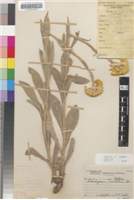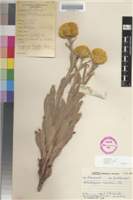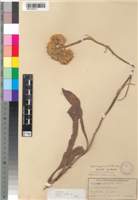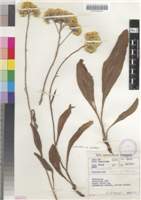Common names:
Sword-leaved everlasting, Velvet-leaved everlasting, Sticky everlasting, Taai sewejaartjie (A), Uzangume (Z), Double everlasting
Origin of name:
acutus / -a / -um = with sharp point, sharpened slightly
acutum refers to sharp pointed bracts
Diagnostic characters:
Large leaves (sessile or petiolate) with prominent nerves
Large compact, often branched inflorescence
Bright tumeric-yellow bracts
Description:
Perennial herb, rootstock stout, woody, crown sometimes woolly, often with remnants of burnt stems, leaves mostly basal, flowering stems solitary or several together, erect to 450 (�600) mm, simple, cobwebby to woolly-tomentose, leafy in the lower part, pedunculoid and bracteate upwards. Radical leaves up to 250 (�350) x 50 (�80) mm, c. a third to one half of the length petiolar, blade elliptic, ovate-elliptic or ovate tapering smoothly or more abruptly into the long, winged petiole, base expanded and clasping, apex acute, both surfaces glandular-punctate, often thinly or thickly glandular-pubescent, frequently lightly cobwebby to densely greyish-woolly as well, conspicuously triplinerved with a prominent midrib (a KwaZulu-Natal form sticky, hairless and with a rough surface); cauline leaves similar but soon sessile, oblong-lanceolate, very acute to long acuminate passing into distant linear-lanceolate acuminate bracts. Heads homogamous, oblong-campanulate, c. 5�7 x 3 mm, many in dense corymbose clusters, open or tightly corymbosely arranged. Involucral bracts in c. 4 series, closely imbricate, outermost webbed together with wool, inner slightly shorter than or equaling the flowers, tips acute or very acute, pellucid, bright yellow, not radiating. Receptacle shortly honeycombed. Flowers 7�13. Achenes 1,25 mm long, with myxogenic duplex hairs. Pappus bristles many, slightly shorter than corolla, scabridulous, bases cohering strongly by patent cilia, some light fusion as well.
Flowering between September and January.
Distribution:
Grows in exposed grassland with rocky outcrops. Widespread, from sea level to c. 1950 m. Ranges from Baziya (W. of Umtata) through Eastern Cape, KwaZulu-Natal, Swaziland, Gauteng Highveld and Mpumalanga highlands to the Soutpansberg in Limpopo Province, and in the North West Province, with closely related plants in tropical Africa (Zimbabwe, Malawi and Tanzania).
Grassland, Savanna and Thicket Biomes.
Notes:
Plants are commonly thickly tomentose, but all degrees of development of woolly hairs occur, and sometimes wool is either completely wanting or confined to the leaf margins.
Taxonomy:
Literature:
Helichrysum acutatum DC. Prodr. 6: 186 (1838); Harv. in F.C. 3: 234 (1865); Moeser in Bot. Jb. 44: 275 (1910); Compton, Fl. Swaziland 627 (1976); Hilliard, Compositae in Natal194 (1977).
Type:
Eastern Cape, between the Umzimkulu and Umtentu Rivers, Dr�ge 4999 (G-DC, holo.).
Synonym(s):
Gnaphalium acutatum (DC.) Sch. Bip. in Bot. Ztg 3: 171 (1845).
Helichrysum floccosum Klatt in Bull. Herbarium Boissier 4: 836 (1896). Type: KwaZulu-Natal, Durban distr., Northdene, Wood 5231 (Z, holo.; BM; K; PRE, iso.).
H. dana� S. Moore in J. Bot., Lond. 37: 371 (1899). Type: KwaZulu-Natal, Zululand, Gerrard s.n. (BM, holo.; K, iso.).
H. schlechteri H. Bol. in Trans. S. Afr. phil. Soc. 18: 387 (1907); Compton, Fl. Swaziland 634 (1976). Lectotype: Gauteng, Elandsspruitberg, 2 070 m, Schlechter 3952 (BOL; BM; G; K; PRE; S; Z, isolecto.).
H. acutatum var. rhombifolium Moeser in Bot. Jb. 44: 275 (1910). Type: KwaZulu-Natal, Inanda, Rehmann 8296 (Z, holo.).
H. galpinii Schltr. & Moeser in Bot. Jb. 44: 274 (1910), non N.E. Br. (1896). H. transvalense Staner in Annls Soc. scient. Brux., s�r. B, 56: 249 (1936). Type: Mpumalanga, Barberton, Saddleback Range, Galpin 607 (BOL; K; NH; PRE; Z, iso.).
H. eriophorum Conrath in Kew Bull. 1914: 133 (1914). Type: Gauteng, Irene, Conrath 432 (K, holo.).
Vouchers:
Bremer 603 (NU); Codd 3306 (NU; PRE); Hilliard & Burtt 5979 (E; K; NU; PRE); Moll 1889 (NU); Wood 11855 (NU); Germishuizen 3851 (PRE); Acocks 20 884 (PRE).
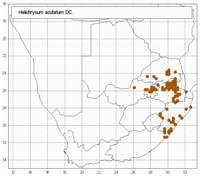
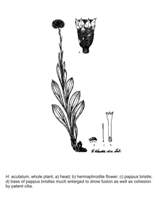
_sml.jpg)
_sml.jpg)
_sml.jpg)
_sml.jpg)
_sml.jpg)
